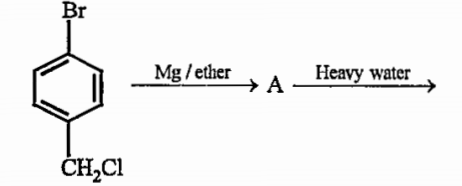In the reaction of benzamide with hypobromite CO group is obtained in the form of:
CO
CO2
CO2−3
HCO−3
To solve the problem of how the CO group is obtained in the reaction of benzamide with hypobromite, we can break it down into the following steps:
Step 1: Understand the Reactants
Benzamide is an aromatic amide with the formula C6H5CONH2. It contains a benzene ring (C6H5), a carbonyl group (C=O), and an amine group (NH2).
Step 2: Identify the Reaction Conditions
The reaction involves hypobromite, which can be represented as NaOBr (sodium hypobromite). This reaction typically occurs in a basic medium, often using sodium hydroxide (NaOH).
Step 3: Reaction Mechanism
When benzamide reacts with hypobromite in the presence of a base, the carbonyl group (C=O) is involved in a reaction that leads to the elimination of the CO group. The mechanism involves the formation of an intermediate that eventually leads to the release of carbon dioxide (CO2) and the formation of sodium carbonate (Na2CO3).
Step 4: Products of the Reaction
The main products of the reaction are:
- Sodium carbonate (Na2CO3), which contains the CO group in the form of carbonate (CO3^2-).
- Sodium bromide (NaBr) as a byproduct.
- Water (H2O) as another byproduct.
Step 5: Conclusion
Thus, the CO group from benzamide is obtained in the form of carbonate (CO3^2-) after the reaction with hypobromite.
Final Answer
The CO group is obtained in the form of sodium carbonate (Na2CO3), which contains the carbonate ion (CO3^2-).
---
Benzamide is an aromatic amide with the formula C6H5CONH2. It contains a benzene ring (C6H5), a carbonyl group (C=O), and an amine group (NH2).
The reaction involves hypobromite, which can be represented as NaOBr (sodium hypobromite). This reaction typically occurs in a basic medium, often using sodium hydroxide (NaOH).
When benzamide reacts with hypobromite in the presence of a base, the carbonyl group (C=O) is involved in a reaction that leads to the elimination of the CO group. The mechanism involves the formation of an intermediate that eventually leads to the release of carbon dioxide (CO2) and the formation of sodium carbonate (Na2CO3).
The main products of the reaction are:
- Sodium carbonate (Na2CO3), which contains the CO group in the form of carbonate (CO3^2-).
- Sodium bromide (NaBr) as a byproduct.
- Water (H2O) as another byproduct.
Thus, the CO group from benzamide is obtained in the form of carbonate (CO3^2-) after the reaction with hypobromite.
The CO group is obtained in the form of sodium carbonate (Na2CO3), which contains the carbonate ion (CO3^2-).
Similar Questions
Knowledge Check
Plants obtain Fe in the form of
AFerric ionsBFerrous ionCEither ferric or ferrous ionsDFeSO4−CH2OH group is obtained by reduction of
AR-CNBR−NO2CR-CO-RDR-COOHStreptomycin is obtained from
AStreptomyces ramosumBS. grieseusCS. nodosusDS.erytherus

